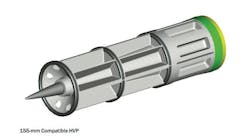Army wants to develop hypervelocity artillery shells for air defense against manned and unmanned aircraft
FORT BELVOIR, Va. – U.S. Army air-defense experts are asking industry to develop prototypes of hypervelocity artillery shells to defend against enemy aircraft, missiles, artillery projectiles, and unmanned aerial vehicles (UAVs).
Officials of the Army Rapid Capabilities and Critical Technologies Office (RCCTO) at Fort Belvoir, Va., issued a request for information on Monday for the Hypervelocity Projectile (HVP) project.
Army officials want a company able to deliver HVP prototypes no later than fall 2027 for operational demonstrations in 2028, and later for possible deployment. Hypervelocity projectiles fly through the air at speeds of 8 or 9 times the speed of sound.
The HVP for air defense applications seeks to reduce munition costs and enhance the value of wheeled 155-millimeter artillery systems firing HVPs. The HVP prototypes will communicate with off-board sensors that track the HVP and the threat to be intercepted. BAE Systems has developed a hypervelocity projectile for potential naval use.
The HVP prototypes must be compatible with the Multi-Function Precision Radar (MFPR) and Hypervelocity Gun Weapon System (HGWS), to be delivered under separate projects. Delivery of the HPV prototypes must be no later than fall 2027, with demonstrations set for 2028.
The HVP prototypes should fire from rifled and smooth-bore 155-millimeter cannons; interface with Army-provided off-board sensors to intercept the incoming threat; interface with a data transmission device to receive pre-launch mission data; maintain projectile maneuverability through interception; keep flight time to a minimum; be powerful enough to shoot down fixed-wing aircraft and helicopters; UAVs; and cruise missiles. Army officials also are interested in rapid ammunition resupply, as well as supportability, safety, and cyber security.
Companies interested should email unclassified capability statements no later than 24 July 2024 to the Army's Joshua Flinn at [email protected] and Sydney Horn at [email protected]. Email questions to Flinn and Horn no later than 17 July 2024.
More information about the Hypervelocity Projectile (HVP) request for information is online at https://sam.gov/opp/8e1e28029c9f4e5ba5fa56d52af0cba6/view.
About the Author
John Keller
Editor-in-Chief
John Keller is the Editor-in-Chief, Military & Aerospace Electronics Magazine--provides extensive coverage and analysis of enabling electronics and optoelectronic technologies in military, space and commercial aviation applications. John has been a member of the Military & Aerospace Electronics staff since 1989 and chief editor since 1995.
